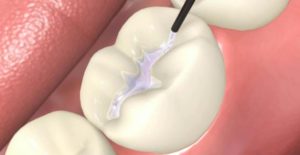A fissure sealant is a very effective method of protecting molars from decay during childhood. Designed as a coating to be painted over the teeth, this preventive material creates a barrier between the enamel and the bacteria that would otherwise build up freely. Sealants provide unique protection in deep fissures, where your toothbrush can’t reach without affecting your ability to chew or causing any permanent changes to the enamel.
Sealants help prevent long-term damage that can occur as a result of decay and subsequent restoration, such as fillings. You and your dentist can decide together which teeth are most likely to benefit from a sealant.
What to Expect During a SEALANT Procedure
Placing dental sealants is usually painless and doesn’t require drilling or numbing medications.
- Tooth preparation – first, the dental hygienist/ dentist will polish the surface of the tooth to remove plaque and food debris from the pit and fissure surfaces. Next the hygienist will isolate and dry the tooth. Then the hygienist will etch the surface of the tooth, rinse off the etching material and dry the tooth.
- Sealant application – the hygienist will apply the dental sealant material to the surface of the tooth with a brush; a self-curing light will be used for about 30 seconds to bond the sealant to the tooth surface.
- Evaluation – finally, the dental hygienist and dentist will evaluate the dental sealant and check its occlusion. Once the dental sealant has hardened it becomes a hard plastic coating, and you can chew on the tooth again.



